UK and US seismic bombs
"Wrecked" by engineer Wallace
At the very end of the thirties, English aircraft designer and employee of Vickers-Armstrong Ltd. Barnes Wallace, convinced of the need for massive strategic bombardment of Germany, was working on options for promising aviation ammunition. Among other things, underground concrete bunkers have received his attention. According to Wallace's calculations, none of the then existing air bombs could destroy or at least cause appreciable damage to an underground structure with good protection. However, the designer was able to establish that to hit a target, a bomb should fall into the ground when it falls. In this case, the explosion would create a real seismic wave, which would ensure the destruction of the target. This principle is called the "seismic bomb."
Calculations of the same time allowed to establish the optimal appearance of such a munition: a heavy streamlined bomb designed for dropping from altitudes of at least 10-11 kilometers. In this case, the bomb could accelerate in the fall to a very high speed and thanks to it to go deeper into the ground. The fuse was supposed to be adjusted to explode after penetrating the ground. The resulting small earthquake, depending on the power of the bomb, could destroy ground and underground structures within a radius of at least several tens of meters.
Unfortunately, the idea of a seismic bomb did not interest the British military department and put it on the shelf. A little later, in 1941, B. Wallace proposed a new concept for the original aircraft munitions - the so-called. jumping bombs to destroy dams. In May, 43-th with the help of similar bombs, British aircraft destroyed two German dams and damaged another one. Despite the relatively large losses during the combat departure, the command of the Royal Air Force recognized the effectiveness of the proposal of Wallace. For this reason, the command asked him to continue research on the topic of seismic anti-bunker bombs.
By the beginning of 1944, Wallace had completed the design of the first seismic bomb, called the Tallboy ("Big Man"). The resulting ammunition fully justified its name: a drop-shaped body with a length of 6,35 meters and a diameter of 95 centimeters. The total weight of the bomb exceeded kilogram 5400. It is worth noting that it was originally planned to make the initial version of a bomb weighing ten tons, but Britain did not have an aircraft that could cope with such a load. Since the bomb had to penetrate the ground and hit the target with a minimum deviation, the designer applied several interesting solutions. First, the bomb case had rather thick walls made of alloy steel. This feature of the "Versie" allowed in the future to enter the ground without noticeable deformations and damage. The second technical solution concerned the accuracy of the bombing. So that the ammunition did not deviate from the calculated trajectory, it was equipped with four small stabilizers mounted at an angle. As a result, the bomb, gaining speed, spun around its axis and behaved like an artillery projectile.
A seismic wave in the ground was created by a bomb charge: 5200 pounds (about 2360 kg) of torpex - a mixture of TNT, RDX and aluminum powder. This explosive had previously proven itself in torpedoes. Undermining the charge was proposed to produce using a fuse, the type of which was suitable for a specific task. The main explorer was the No. XXNX detonator with a retarder, but if necessary, the contact No. IXNX fuses could also be used. An interesting technology is the manufacture of a bomb: molten torpex was poured inside a molded case installed vertically, after which it froze. Due to the huge amount of explosives, it took several weeks.
To use the bombs "Tollboy" had to modify the aircraft carrier. Avro Lancaster bombers, which were supposed to carry a bomb, lost almost all armor plates and most of the weapons. Also, the cargo compartments of the aircraft, which was equipped with new wing doors and reinforced suspension devices, have undergone significant alterations. However, even in the lightweight version, the Lancaster could not lift Tallboy by the calculated height of 40 thousand feet (12,2 km). Therefore, during the test bombings, it was found out that it is enough for a bomber to fly at an altitude of 25 in thousand feet (about 7,7 km) and this will be enough for the bomb to drop in speed in the fall. Finally, a special SABS sight was developed to provide the accuracy needed.
In the course of testing it was possible to find out the following feature of the munition. The Tallboy bomb in the fall from the calculated height could accelerate to a speed of about 1200 kilometers per hour, which exceeded the speed of sound. Such a supersonic bomb punched up to 30 meters of solid ground or up to five meters of concrete. A further explosion guaranteed to destroy the surrounding buildings on the surface and - most importantly - under the ground.
For the first time, Tallboy bombs were used on the night of June 9 on 1944 - the first night after the opening of the Second Front. The pilots of the 617 Squadron of the Royal Air Force, which by then already bore the name “Dam Destroyers” (it was this unit that attacked German dams a year ago with the help of “jumping bombs”) were assigned to destroy the railway tunnel near the city of Saumur. Total 19 bombs completely smashed the tunnel arches. It is noteworthy that for the successful execution of the operation only one hit was enough: one of the bombs hit exactly into the tunnel, at a distance of about 60 meters from the entrance. "Tollboy" broke through the rock and vault, and the explosion occurred in the tunnel itself. As a result of this penetration into the structure, about 10 thousand cubic meters of rock fell.
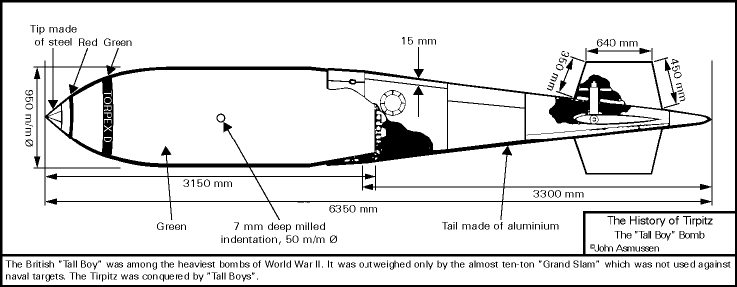
In the remaining months of the war in Europe, pilots from the 617 squadron dropped the 854 Tallboy bomb. Various German fortifications and ships were attacked. We should also note the raids on the German battleship Tirpitz. During the first of these, 15 September 1944, only one bomb hit the ship. Ammunition hit the nose "Tirpitz" and deprived of its course. October 28 bomb did not hit the ship, but its explosion still damaged the propeller shaft. Finally, November 12 pilots hit the ship three times. One of the bombs ricocheted from the armored tower and went into the water, while the other two struck the deck and provoked a fire in the holds. As a result of ignition of one of the powder cellars, an explosion tore off the gun turret. Soon the battleship sank. During the last raid on the Tirpitz, the British lost only one aircraft, which made a hard landing in neutral Sweden.
"Big Cotton"
At the end of June 44, the Royal Air Force attempted to raid a German underground plant located in the Dome Vizierne bunker (also known as the Elfo Dome). The dropped Tallboy bombs were able to damage some parts of the bunker dome design, but none of them coped with the dome itself. In connection with this incident at the firm “Vikkers” under the leadership of Wallace resumed work on the subject of a ten-ton seismic bomb.
Structurally, the new ammunition with the name Grand Slam ("Big Cotton") was an enlarged version of the "Bigger". The bomb's hull was extended to 7,7 meters, and the diameter increased to 1,17 meters. The weight increased accordingly - to almost ten tons, of which 9140 pounds (about 4500 kg) accounted for torpex. This amount of explosive after pouring cooled for almost a month. During the tests, the Grand Slam showed almost the same speed as the previous Tallboy. It also accelerated to supersonic speeds, however, showed the best indicators of penetrability. The “Grand Slam” was plunging into the ground on 35-40 meters and at the same time much better than “Tollboy” breaking through concrete barriers. Part of the Grand Slam test bombing was done on the captured Vizerne Dome bunker. The dome of the structure was seriously damaged, but still survived. Nevertheless, the characteristics of the new bomb were considered sufficient for practical use.
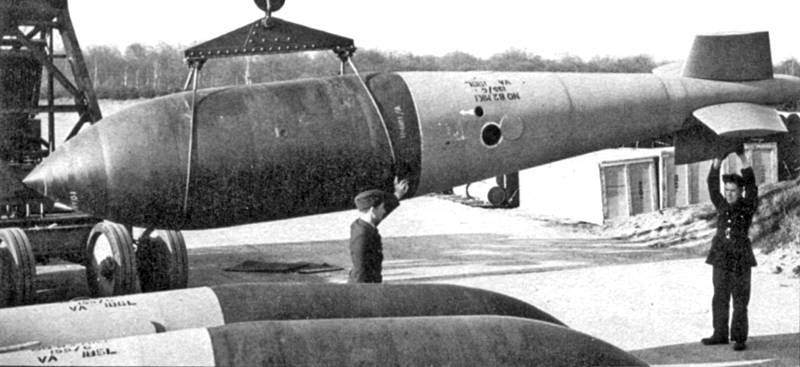
For the first time, the “Big Cotton” sounded 14 March 1945, near the city of Bielefeld. During the raid on the railway viaduct, the pilots of the 617 th squadron dropped one new bomb and several Tallboy ammunition. The explosions destroyed about 30-35 meters of construction. The next day, a viaduct in Arnsberg suffered a similar blow. However, this time the two Grand Slam and 14 Tallboy bombs did not produce any tangible results: the design of the viaduct was damaged, but these damages were not sufficient to destroy it.
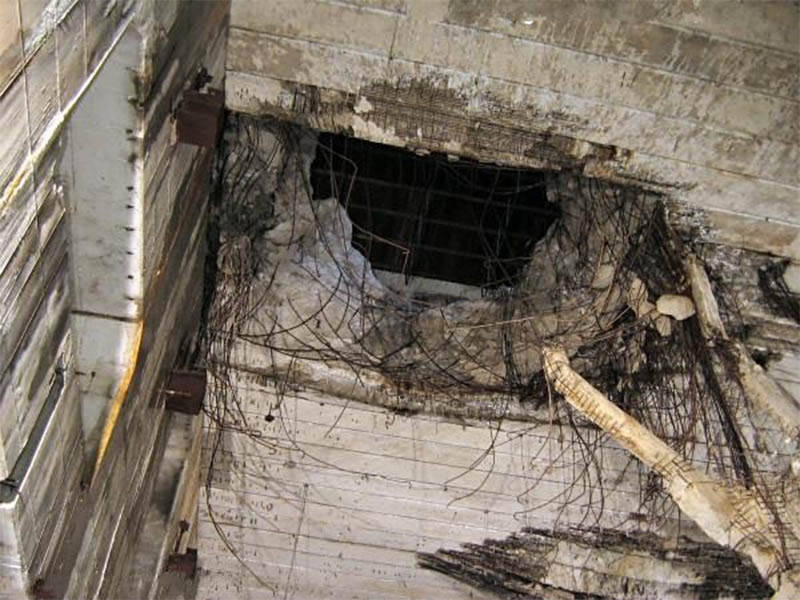
British air operations with the use of both types of seismic bombs continued until mid-April. During this time, the 617 Squadron pilots dropped the Big Cotton 42 bomb and destroyed a large number of targets. Especially successful was considered a raid on the Valentin bunker. In this structure was planned to make a new plant for the construction of submarines. The roof of the bunker in some places had a thickness of up to seven meters. During the 27 raid in March of 45, two Grand Slam bombs were stuck in the roof of a structure on a plot about 4,5 meters thick and exploded inside the concrete structure. Part of the roof collapsed, and the remaining ceiling cracked and could not be restored.
American record
After seeing the effectiveness of the British bunker bombs, the United States also launched a similar project. However, taking into account the experience of using Tallboy and Grand Slam, the Americans changed the face of a promising bomb. First of all, the weight and, as a result, the dimensions of the munition were adjusted. Calculations showed that a bomb with a total weight on the order of 18-19 tons was required to ensure the destruction of the then prospective bunkers. The project received the T-12 index and the code name Cloudmaker ("Creating the clouds").
The American bomb was an enlarged version of the British ammunition. During the development, however, it was necessary to take into account some technological nuances, due to which the weight of the finished bomb went beyond the intended framework. The finished Cloudmaker weighed 20 tons and was about twice as tall as Tallboy. Torpex explosive charge - about eight tons. The weight and dimensions of the new seismic bomb were such that only one aircraft could carry it — the Convair B-36 Peacemaker bomber.
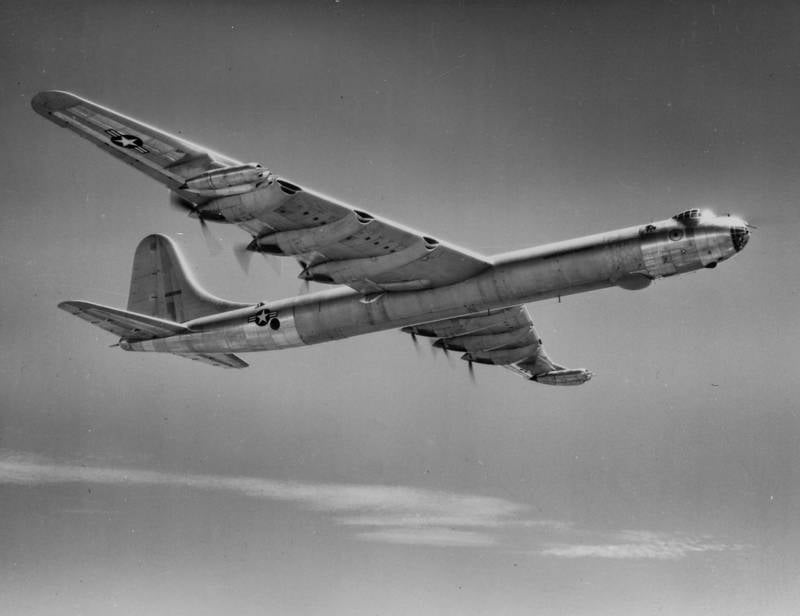
However, the Pismaker did not immediately become the carrier of the T-12 bomb. First made several test dumps from a smaller aircraft, the Boeing B-29 Superfortress. For testing specially remade serial bomber. It was made as easy as possible by removing all unnecessary details (armor and weapon), remade the cargo compartment to accommodate a large ammunition, and also appropriately calculated the amount of fuel poured. Until the first test bomb was dropped, everyone involved in the project was very nervous: nothing could tell how the bomber would behave, the maximum take-off mass of which was only three times the mass of the bomb. The designers feared that the plane, which was freed from the load, would throw up, and the resulting overload would damage its design. Fortunately, the test pilots coped with the abrupt cabreling and the B-29 returned safely to its airfield.
According to some data, during the tests, the T-12 bomb dropped from a height of ten kilometers penetrated to 50-55 meters of soil or to 8-10 meters of concrete. Thus, the capabilities of the new American ammunition were significantly higher than that of any other bombs of this class. In addition, due to the principle of its operation, a seismic bomb in depth in some cases could be more effective than nuclear weapons exploding in the air or on the surface of the earth.
Shortly after the B-29 began testing, the first reset of the Cloudmaker from the B-36 aircraft took place. For a heavy strategic bomber, this procedure was completely safe, although the Peacemaker had to be redone accordingly. In January 1949, as an experiment, one B-36 took off at once with two T-12 bombs. The flight took place without incident, although the bomb load in 43 tons (two bombs and suspension devices for them) exceeded the maximum allowed.
In the same year, the 1949, the T-12 Cloudmaker bomb was adopted. Around the same time, the chiefs of the Pentagon finally decided on the priorities for the development of their air force. Now the strategic bombers B-36 were considered solely as carriers of nuclear weapons. Cloudmaker bombs that have a specific tactical niche have lost their priority. Finally, in the mid-fifties, American nuclear engineers created several new nuclear bombs that acted like seismic ones: they “stuck” into the ground and exploded there. These munitions turned out to be much smaller and lighter than the “Cloudmaker”, which is why they could be transported not only by B-36, but also by other American bombers of that time.
The T-12 Cloudmaker seismic bomb was in service with the US Air Force until the end of the fifties. 12 February 1959, the command ordered the removal of the B-36 bombers. Since no other aircraft could use the T-12 super-heavy bomb, it was also excluded from the list of weapons of the American air force. In the future, the United States did not deal with the themes of ultra-large-caliber anti-bunker bombs. This niche was firmly occupied by less heavy ammunition with sufficient characteristics. In addition, over the past decades, the bomb is accelerated to the desired speed, not in a free fall, but with the help of a solid-fuel accelerator. The time of huge seismic bombs weighing several tons has passed.
On the materials of the sites:
http://barneswallistrust.org/
http://sirbarneswallis.com/
http://bismarck-class.dk/
http://airpower.maxwell.af.mil/
http://defenseindustrydaily.com/
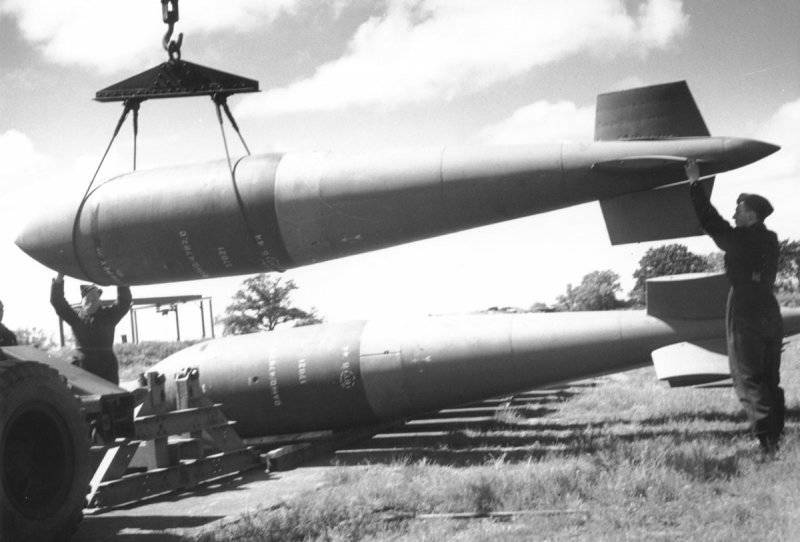
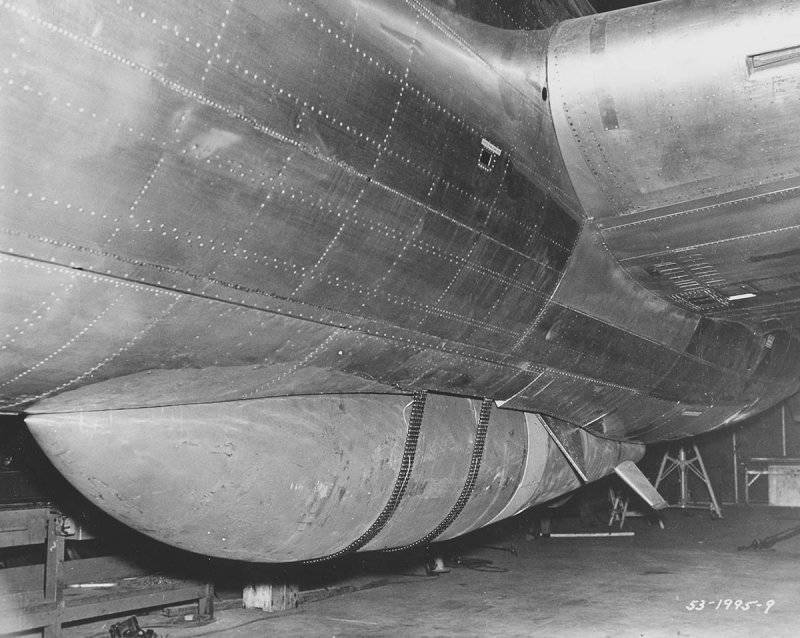
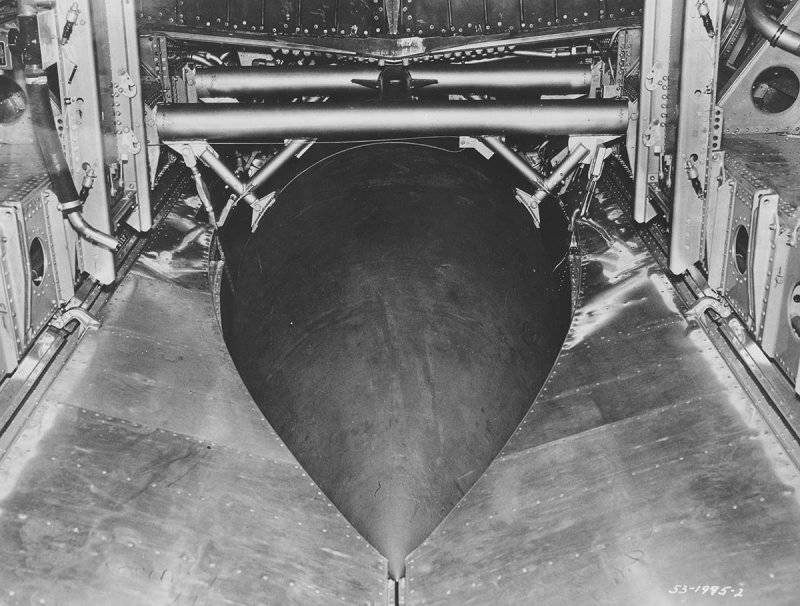
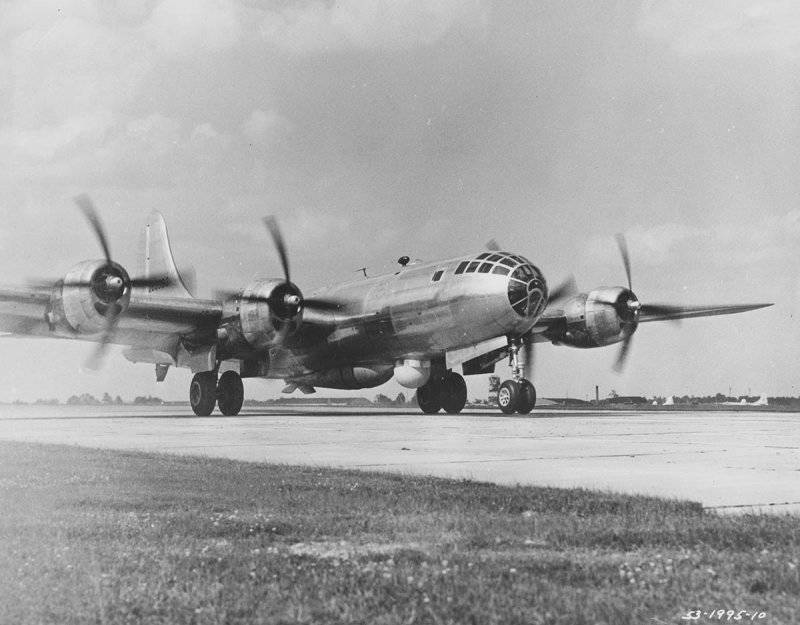
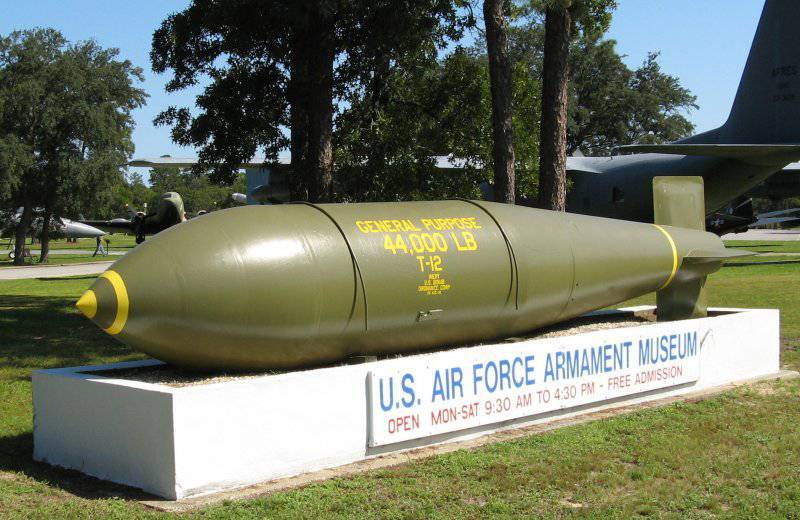
Information